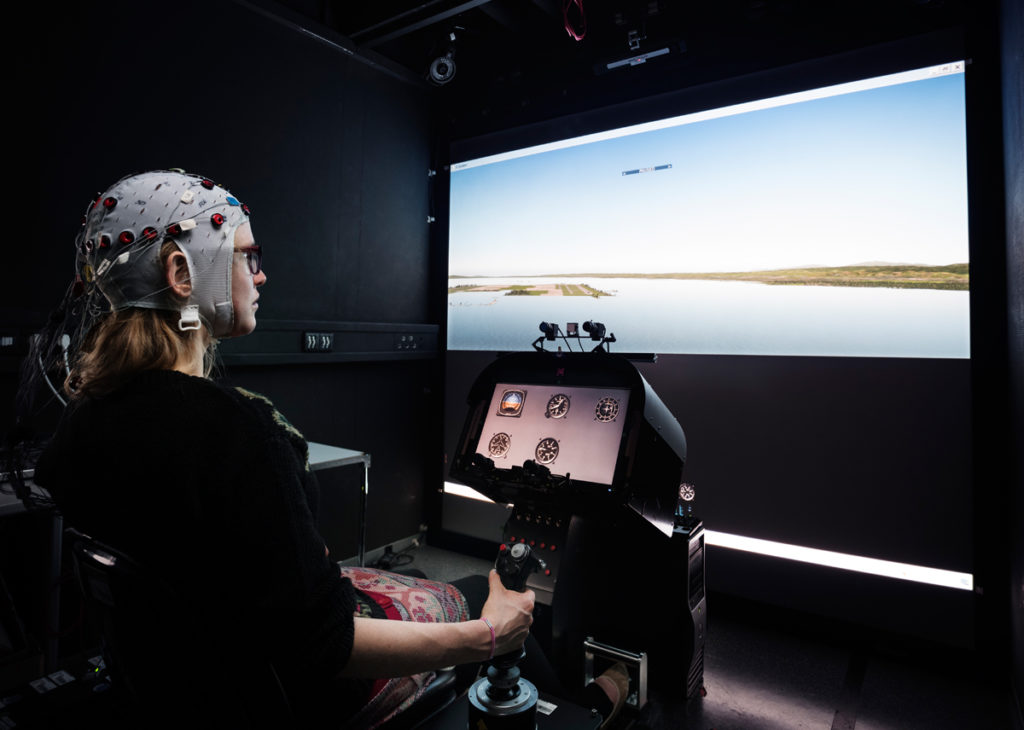Vehicle handling is a task that places high demands on our visual system. When driving a car, we have to constantly attend to visual factors such as our distance to the car in front of us, our lane-position, road-signs, and more. Therefore, perceptual distraction during driving can be expected to impair our ability to handle a vehicle. Nonetheless, some levels of distractibility can sometimes be beneficial – it can grant us access to unanticipated events that might be relevant. In our new article, published in the journal Frontiers in Human Neuroscience, we investigate how neural activity changes in order to maintain the balance between driving performance and the perception and processing of events outside of the focus of our visual attention.

We are intuitively aware of the negative consequences of distraction during driving. For example, it is generally acknowledged that phone use during driving can increase the risk of dangerous driving. An influential risk analysis conducted in the United States attributed driver inattention as a factor in 78% of crashes and 68% of near-crashes 1.
Meanwhile, the positive consequences of distraction are less obvious. But being over-engaged with vehicle-handling to the extent that we are unable to be distracted by other more critical events can be just as dangerous. An unfortunate collision between a commercial airliner and business jet that resulted in 154 fatalities occurred because pilots failed to notice a visual text message that informed them that their transponding systems was no longer transmitting their position to nearby aircraft 2. Experiments performed in flight simulators have shown that commercial pilots can even fail to notice entire aircrafts and radio towers when relying on highly-engaging heads-up augmented reality displays 3. This raises the question: Which aspects of visually engaging tasks, such as steering, are likely to decrease our awareness of our environment?
In our study, we investigated how this balance is preserved during changing demands of the driving task. Participants were required to steer while we used EEG to measure the brain’s response to non-steering events, such as unexpected sounds. We found that the brain’s response to ‘distracting’ events was reduced when demands in the steering task were increased. More importantly, we identified three neural components in the EEG that were selectively influenced by steering demands. Given their relatively late occurrence (300 ms after the distracting event occurred), psychological theories of distraction would suggest that the distracting stimuli that elicited these responses were still detected by the perceptual system. However, they were unlikely to have fully engaged and been meaningfully processed by the brain. This suggests that increases in steering demands (e.g., slippery road conditions, increased road curvature), can inhibit our ability to process distracting events at the neural level.
In summary, we employed EEG to identify a sequence of neural responses that responded to our participants’ engagement with an immersive and continuous visual task, namely steering. We believe that these same components can be generalized for use in evaluating of user-engagement with other visual tasks, for example with interactions with information visualizations on large displays. In fact, we expect the evaluation of in-vehicle information visualization and its impact on steering engagement to be a critical safety issue as heads-up display systems, for route-finding and lane-changing, become increasing prevalent in modern vehicles 4.
Reference:
Scheer M, Bülthoff HH, & Chuang LL (2016): Steering demands diminish the early-P3, late-P3 and RON components of the event-related potential of task-irrelevant environmental sounds. Frontiers in Human Neuroscience 10(73), 1-15.
1 Klauer, S. G., Dingus, T. A., Neale, V. L., Sudweeks, J. D., & Ramsey, D. J. (2006). The impact of driver inattention on near-crash/crash risk: An analysis using the 100-car naturalistic driving study data. DOT HS 810 594. Washington, DC: US Department of Transportation
2 Command of Aeronautics(2006) final reportA-0-22CENIP A /2008.Brazil. Command of Aeronautics, General Staff of the Aeronautics, Aeronautical Accident Investigation and Prevention Center (CENIPA).(2008). Aeronautical Accident, PR.GTD and N60OXL, B-l378EH and EMB-l35BJ Legacy, 29 September2006. Brazilia, Brazil: Cenipa
3 Wickens C.D., & Alexander, A. L. (2009). Attentional tunneling and task management in synthetic vision displays International Journal of Aviation Psychology, 19, 182-199
4 Doshi, A., Cheng, S. Y., & Trivedi, M. M. (2009). A novel active heads-up display for driver assistance. Systems, Man, and Cybernetics, Part B: Cybernetics, IEEE Transactions on, 39(1), 85-93.

